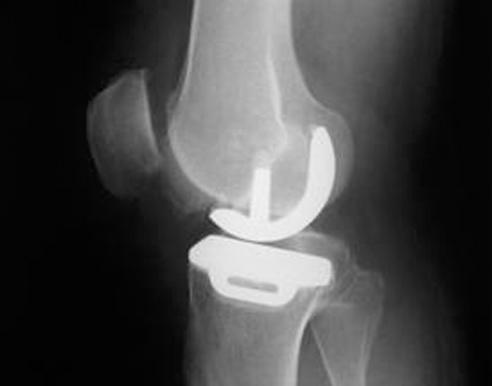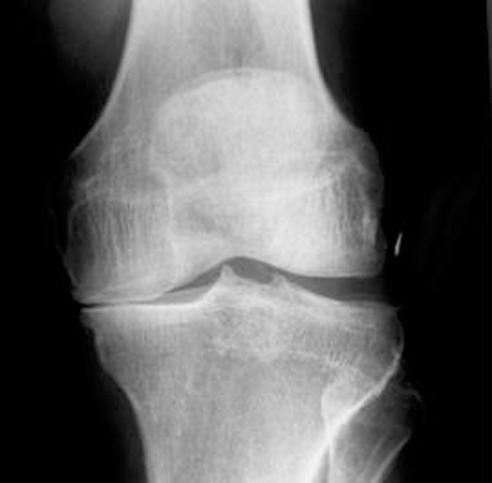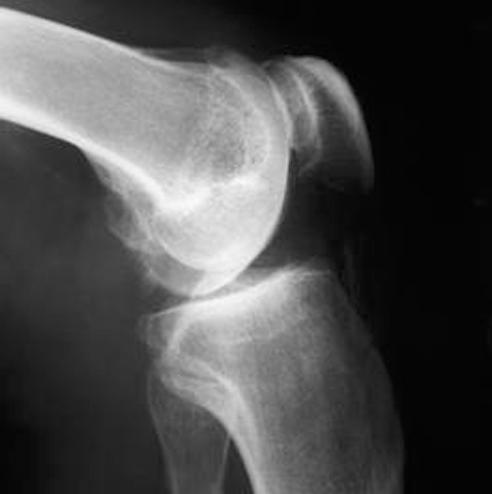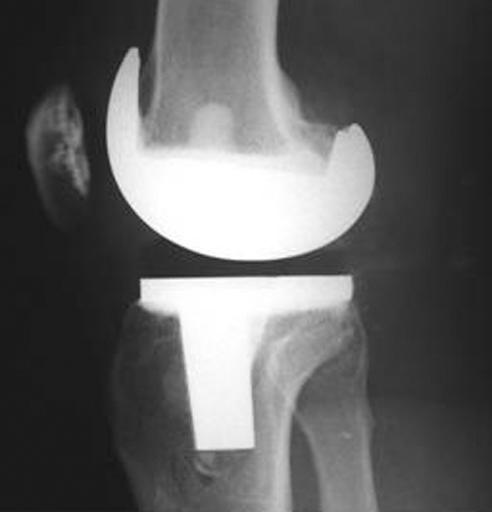Osteoarthritis of the knee is common, affecting almost a tenth of the population aged over 55.1 This proportion is likely to increase with extended longevity and a bigger body mass index. Most patients with osteoarthritis of the knee are able to manage their symptoms without medical treatment, but a large proportion of those referred to orthopaedic surgeons have debilitating disease, presenting chiefly with pain and stiffness. Classically the pain depends on activity, and in severe cases not only limits the distance patients can walk and their daily activities, but also disrupts sleep. Moreover, whereas most patients are past retirement, a major proportion is of working age, leading to difficulties with work and presenting an important economic cost to society.
Non-surgical treatment of osteoarthritis of the knee is primarily carried out in the community. This article concentrates on the interventions and surgical options used by orthopaedic surgeons for the treatment of this disease, indications for their use, and likely outcomes.
Sources and selection criteria
We searched Medline (1966 to May 2004) using the terms “osteoarthritis”, “knee”, “knee replacement/arthroplasty”, “osteotomy”, “arthroscopy”, “and outcome”. We were particularly interested in papers from leading peer reviewed orthopaedic and rheumatological journals. We searched the Cochrane database of systematic reviews, the health technology assessment database, and the database of abstracts of reviews of effects.
Non-operative treatment
Management of patients with mild osteoarthritis should be tailored to the individual while avoiding over-medicalisation of the condition.w1 A variety of interventions are available, including advice on changes to lifestyle and physical and pharmacological therapies. The effectiveness of many of these treatments has been reviewed elsewhere.2,3
Intra-articular steroid injections
Intra-articular steroid injections can alleviate pain in patients with moderate osteoarthritis of the knee, but this is usually short lived,2 and therefore we believe they have a limited role in treating acute exacerbations of the disease. A recent randomised double blind trial, however, has suggested that repeated injections of the steroid triamcinolone hydrochloride every three months for up to two years can lead to improved symptoms when compared with injections of saline.4 The effect was more noticeable at one year. Evidence that steroids accelerate cartilage damage is still inconclusive, but there is a small risk of septic arthritis (between 1 in 15 000 and 1 in 50 000).2 A Cochrane review of the available evidence is in preparation.
Summary points
The outcome of total knee replacement is comparable to that of total hip replacement
85% of total knee replacements are carried out for patients with osteoarthritis
Arthroscopic debridement and washout has a role as a temporising procedure in early osteoarthritis associated with mechanical symptoms
In some cases alternative surgical procedures such as unicompartmental knee replacement may be more appropriate than total knee replacement
The role and success of new techniques such as image guidance and minimally invasive surgery remain to be established
Viscosupplementation
Several hyaluronan preparations are available as intraarticular injections. Relief of symptoms is thought to result from increased viscosity of the synovial fluid—hence the term “viscosupplementation” for this type of treatment. The molecular weights of the hyaluronan derivatives vary as do the duration of courses and the numbers of injections recommended. The results of trials also differ, with some implying little benefit and others showing excellent results.5 w2 w3 A recent systematic review concluded that injections of hyaluronic acid were no more effective than nonsteroidal anti-inflammatory drugs for improving pain, physical function, and stiffness, and did not support public funding of viscosupplementation.6
Surgical intervention
Indications
The impact of disease on lifestyle is the most important factor in assessment of patients with osteoarthritis of the knee. Surgery should be resisted when symptoms can be managed by non-surgical means. Indications for surgical intervention are debilitating pain and major limits on daily activities and distance walked, or impaired ability to sleep or work.
Another consideration is the patient's health and fitness for anaesthesia. The risks as well as potential benefits of surgery need to be discussed with the patient. Several surgical techniques are available (box).
Arthroscopic washout and debridement
The role of arthroscopic debridement for degenerative arthritis of the knee is controversial. It has been shown that improvement of symptoms in an unselected cohort of patients allocated to either washout or washout and debridement could be attributed to a placebo effect.7 Prospective randomised controlled trials looking at subsets of patients with differing levels of symptoms and disease are scarce. Some studies do suggest that arthroscopic treatment used in a more selective manner can control symptoms of osteoarthritis of the knee for up to five years.8,9 Factors correlating with a better outcome include the presence of mechanical symptoms of painful locking or catching of the knee, mild to moderate radiographic evidence of arthritis, and a younger age at the time of surgery. The presence of limb malalignment is associated with a less successful outcome. For this reason we believe that arthroscopic debridement should principally be used in younger patients with osteoarthritis, with meniscal lesions or chondral flaps amenable to debridement. Delaying inevitable joint replacement is particularly desirable in these patients. Further clinical study of this subset of patients within the context of a randomised controlled trial would be helpful.
Osteotomy of the proximal tibia or distal femur
In healthy knees, the weightbearing axis passes from the centre of the hip to the centre of the ankle joint, through the centre of the knee. In osteoarthritis, the alignment of the leg changes because of wear. Medial wear creates a bow legged appearance (varus), and the weightbearing axis moves medially. Lateral wear creates a knock knee (valgus) deformity, and the weightbearing axis moves laterally. Osteotomy around the knee moves the weightbearing axis to the less damaged compartment (fig 1).
Fig 1.


Preoperative and postoperative radiographs of a varus knee with medial compartment osteoarthritis before and after opening wedge tibial osteotomy
Surgical options for osteoarthritis of the knee
Established techniques
Arthroscopic washout and debridement of the joint
Osteotomy of the proximal tibia or distal femur
Unicompartmental knee replacement
Patellofemoral replacement
Total knee replacement
Evolving techniques
Computer assisted surgery (image guidance)
Minimally invasive knee replacement
Recovery is prolonged and relief of symptoms often incomplete, but osteotomy may delay the need for total knee replacement for five to 10 years.10,11 Successful treatment could allow a return to sport—something ill advised after arthroplasty. The risks specific to this surgery depend on the technique, and include non-union at the osteotomy site, common peroneal nerve injury, pain from the proximal tibiofibular joint, and over-correction or under-correction of the deformity. Part of an ongoing debate within the orthopaedic community concerns the relative merits of high tibial osteotomy compared with unicompartmental knee replacement in younger patients. The evidence for osteotomy in itself is the subject of an ongoing Cochrane review.
Unicompartmental knee replacement
Up to a quarter of patients with osteoarthritis of the knee have predominantly arthritis of the medial compartment. The surgical options for such patients are medial unicompartmental knee replacement (fig 2), proximal tibial or distal femoral osteotomy, and total knee replacement.
Fig 2.




Unicompartmental knee replacement in a patient with medial compartment osteoarthritis (varus deformity corrected)
Unicompartmental knee replacement requires a smaller surgical approach than for total knee replacement, leading to less blood loss and quicker rehabilitation. The range of knee motion after unicompartmental knee replacement is generally superior to that after total knee replacement. Finally, revision of a unicompartmental knee replacement to a total knee replacement is potentially more straightforward than revision of a total knee replacement.w4
The prerequisites for unicompartmental knee replacement are well defined. These include stability of the joint, a correctable varus deformity, a fixed flexion deformity of less than 10 degrees, and minimal lateral compartment disease. Radiographic evidence of patellofemoral osteoarthritis is not necessarily a problem provided that patients do not have major anterior knee pain. Two studies have reported survivorship rates for implants of 95% and 98% at 10 years.12,13 These rates are comparable to the best reported for total knee replacement and are an improvement on rates previously reported for unicompartmental knee replacement. A recent systematic review of the evidence supports the use of the Oxford unicompartmental knee replacement in patients with arthritis of the medial compartment provided they fulfil the indications.14
The relative merits of unicompartmental knee replacement over total knee replacement or proximal tibial osteotomy in young (less than 60 years) active patients continue to be debated. Unicompartmental knee replacement has now become an accepted treatment for older patients with medial compartment arthritis. The results of unicompartmental knee replacement in lateral compartment disease have yet to be fully determined.
Patellofemoral replacement
Isolated disease of the patellofemoral joint occurs in up to a tenth of patients with osteoarthritis of the knee, and many of these patients are younger than those with tricompartmental arthritis. The surgical options for these patients are arthroscopic debridement, patellofemoral replacement, total knee replacement, or, rarely, patellectomy.
Patients considered for patellofemoral replacement must be assessed for degenerative changes in the rest of the knee joint. Several types of patellofemoral arthroplasties are available but the results have been variable, highlighting the need for careful selection of patients.w4-w6 The most common problems are maltracking of the patella, excessive wear of the polyethylene implant, and disease progression in the rest of the knee joint. The Avon patellofemoral arthroplasty shows promise, although so far published results are only available for five years' follow up.15 Meanwhile, total knee replacement has a place in the treatment of older patients with primarily patellofemoral arthritis, with results that are comparable to patients with tricompartmental disease.16
Total knee replacement
Total knee replacement is a well established treatment for patients with moderate to severe osteoarthritis, with long term results comparable to those of total hip replacement. Between 1991 and 2000 the number of episodes of primary knee replacement registered by the NHS in England more than doubled, to around 33 000 per year. Taking into account the changing demographics of the population, this figure has been estimated to increase by as much as 60% over the next decade, requiring a substantial increase in provision of services.17
Long term studies on survivorship of implants generally use primary end points such as decision to revise the knee replacement (cumulative revision rate). Studies have shown survival rates of between 84% and 98% at 15 years.18,19 w7-w9 The decision on when to revise a knee replacement is largely influenced by the severity of symptoms and the patient's lifestyle, fitness for surgery, and radiological and clinical evidence of complications (usually infection or aseptic loosening). The Swedish knee arthroplasty register has revision rates for over 57 000 knee replacements and revisions carried out since 1975.20 The United Kingdom national joint registry began in 2003, and data on a large proportion of joint replacements are now being recorded.
During the last two decades of the 20th century the designs of total knee prostheses used for primary knee replacement converged towards a bicondylar unconstrained replacement with a polyethylene bearing or insert contained between the femoral and tibial components. These prostheses are classified as either cruciate retaining, where the posterior cruciate ligament is preserved, or posterior stabilised, where the posterior cruciate ligament is removed (fig 3).w10 The posterior stabilised type of prosthesis incorporates a central peg and cam mechanism, theoretically allowing for a greater range of flexion while maintaining anteroposterior stability. Both designs have their advocates and advantages but provide similar long term results.
Fig 3.




Posterior stabilised total knee replacement, with resurfacing of patella
Consensus has still not been reached in some areas of total knee replacement. For example, resurfacing of the patella with a patellar button is practised routinely, selectively, or not at all. The use of a mobile rather than a fixed bearing theoretically reduces contact stresses and therefore wear of the polyethylene (a major cause of osteolysis and aseptic loosening) and provides a better range of motion and functional outcome, although this has not been substantiated to date.21 A major UK multicentre health and technology assessment trial, due for completion in 2011, is looking at these and other contentious issues in knee replacement.
Another ongoing debate concerns the timing of knee replacement surgery. Support is increasing for the view that good results can be obtained in relatively early stages of osteoarthritis, and that there is little advantage in waiting until the patient is in extremis.22 Symptoms do not always seem to correlate with the radiological degree of osteoarthritis,w11 so that a patient with severe symptoms but only moderate radiological changes may none the less merit referral.
As part of informed consent for total knee replacement, patients need to be made aware of potential risks, to both their knee and their general health (table). Complications from total knee replacement have been reported in 5% of patients and 8% of knees.23 More specifically, deep infection occurs in between 0.5% and 1.5% of patients. The incidence of asymptomatic deep vein thrombosis in the perioperative period is high—as much as 50% in some studies. The extent of symptomatic deep vein thrombosis or pulmonary embolism is much lower, around 1% to 3%.23 The risk of death from total knee replacement is around 0.5% within the first 90 days of the procedure.w12
Table 1.
Potential complications of surgery for total knee replacement
| Complications | Immediate | Early | Late |
|---|---|---|---|
| Local |
Haemorrhage or haematoma; nerve injury (“tourniquet palsy,” common peroneal nerve injury); vascular injury, limb ischaemia |
Wound infection; wound breakdown; stiffness |
Deep seated infection with or without loosening; early aseptic loosening |
| General | Anaesthetic complications (for example, myocardial infarction, stroke); nerve injury (spinal anaesthesia, nerve blocks) | Anaemia; deep vein thrombosis; pulmonary embolism; chest infection | Post phlebitic leg |
Additional educational resources
Arthritis Research Campaign (www.arc.org.uk/about_arth/)—A review of the diagnosis and management of osteoarthritis of the hip and knee and guidelines for referral to specialists
British Orthopaedic Association (www.boa.ac.uk)—A consensus statement from the British Orthopaedic Association and British Association for Surgery of the Knee on best practice in total knee replacement
Robertsson O, Knutson K, Lewold S, Lidgren L. The Swedish Knee Arthroplasty Register 1975-1997. An update with special emphasis on 41,223 knees operated on in 1988-1997. Acta Orthop Scand 2001;71: 503-13
Information for patients
Arthritis Research Campaign (www.arc.org.uk/about_arth/)—Booklet on undergoing knee replacement surgery; part of a comprehensive website providing detailed information for patients and healthcare professionals
Arthritis Care (www.arthritiscare.org.uk)—Provides a range of information booklets, runs self management courses, and helps patients access local care groups run by volunteers
American Academy of Orthopaedic Surgeons (orthoinfo.aaos.org)—Detailed information on osteoarthritis of the knee, total knee replacement, and rehabilitation
The American National Library of Medicine and the Patient Education Institute (www.nlm.nih.gov/medlineplus/tutorials/kneereplacementphysicaltherapy/pt049101.html)—Information focusing on knee replacement
Predictable long term side effects of total knee replacement include difficulty squatting or kneeling, numbness lateral to the scar, and mechanical noises, or “clunking,” from the prosthesis.
Strong evidence shows that most patients experience a reduction in pain and improved function after total knee replacement, quantified by specific outcome measures, or “knee scores.”24 However, around half of revision knee replacements occur in the first two to four years after the primary operation. A risk factor for revision shown by the Swedish knee registry was young age at the time of primary surgery.20 Although total knee revision generally improves function, the overall complication rate is significantly greater, at about 26%.23 In one study, an eighth of patients who underwent a revision required re-revision due to complications. These data underpin the reluctance of orthopaedic surgeons to carry out total knee replacements in younger patients, particularly if alternative treatments can, albeit temporarily, control their symptoms.
Several authors have been frustrated by the search for evidence on precise indications for total knee replacement.23 w13 Important progress has been made since the 1980s, particularly in the formulation of knee scoring systems. Some would argue, however, that more careful consideration now needs to be given to the influence of patient characteristics and timing of surgery on the outcome of total knee replacement.
Evolving techniques
Minimal incision approach
A minimal incision approach to unicompartmental knee replacement has become popular, and excellent results have been shown. Modifications have now been made to some total knee replacement systems to allow a minimally invasive approach. Encouraging results have been reported for blood loss, length of hospital stay, and accuracy of implantation.25 Longer term outcome studies are required before this technique can be established more widely.
Image guidance
Computer navigation or “image guidance” in total knee replacement is currently more widely used in Europe and Australia than in the United Kingdom. A variety of systems are available, some of which require data from computed tomograms or magnetic resonance imaging scans before surgery. The technique involves the attachment of infrared beacons or transmitters to specific anatomical landmarks, the surgical instruments, and cutting blocks. Infrared cameras sited around the patient enable the computer to track the position of the instruments relative to the patient's knee. This system may provide a greater degree of accuracy during surgery, particularly for positioning the prosthetic components. The effect of this new technology on the outcome, complications, and survivorship of total knee replacement needs long term evaluation. As more simple, user friendly image guidance systems develop, they will increasingly be combined with minimally invasive surgical techniques and may evolve to be the optimum technique for total knee replacement surgery.
A patient's perspective
I'm 47 and work as a reprographics manager running three university print departments, so I'm always on my feet. I've suffered with osteoarthritis of the right knee for 10 years, but in the last four months the pain became much worse. Walking 100 yards was agonising. Stairs were impossible. The pain stopped me sleeping, so it was affecting my social life too.
I was admitted for a total knee replacement. This was my first operation so I was very nervous. I had a general anaesthetic and knew nothing about the op until I came round. The first 24 hours were uncomfortable, but I had control over the amount of painkiller I required by pressing a button. On the second day I was made to get up, bend the knee a little, and walk a few steps with a frame. The next day I walked to the corridor. After four days I was using crutches to walk up and down the corridor and stairs. I went home after seven days.
It's now five months since my operation. I've just returned home from a holiday in Spain where I managed to walk three miles along the beach. I'm totally pain free and have returned to work. I feel 100% better, can sleep well, and can continue with my life!
Martin Reid
Supplementary Material
 References w1-w13 are on bmj.com
References w1-w13 are on bmj.com
See also p 1216
Contributors: SG and AF jointly developed the idea for this article. SG carried out the literature search and wrote the first draft. AF carried out a detailed review of the draft and further changes. AF is the guarantor.
Competing interests: None declared.
References
- 1.Felson DT. Epidemiology of hip and knee osteoarthritis. Epidemiol Rev 1988;10: 1-28. [DOI] [PubMed] [Google Scholar]
- 2.Dieppe P, Brandt K. What is important in treating osteoarthritis? Whom should we treat and when should we treat them? Rheum Dis Clin North Am 2003;29: 687-716. [DOI] [PubMed] [Google Scholar]
- 3.Walker-Bone K, Javaid K, Arden N, Cooper C. Medical management of osteoarthritis. BMJ 2000;321: 936-40. [DOI] [PMC free article] [PubMed] [Google Scholar]
- 4.Raynauld JP, Buckland-Wright C, Ward R, Choquette D, Haraoui B, Martel-Pelletier J, et al. Safety and efficacy of long-term intraarticular steroid injections in osteoarthritis of the knee: a randomized, double-blind, placebo-controlled trial. Arthritis Rheum 2003;48: 370-7. [DOI] [PubMed] [Google Scholar]
- 5.Leopold SS, Redd BB, Warme WJ, Wehrle PA, Pettis PD, Shott S. Corticosteroid compared with hyaluronic acid injections for the treatment of osteoarthritis of the knee. A prospective, randomized trial. J Bone Joint Surg Am 2003;85-A: 1197-203. [DOI] [PubMed] [Google Scholar]
- 6.Medical Services Advisory Committee. Intra-articular viscosupplementation for treatment of osteoarthritis of the knee. Canberra, Australia: MSAC Application 1045:88; 2003.
- 7.Moseley JB, O'Malley K, Petersen NJ, Menke TJ, Brody BA, Kuykendall DH, et al. A controlled trial of arthroscopic surgery for osteoarthritis of the knee. N Engl J Med 2002;347: 81-8. [DOI] [PubMed] [Google Scholar]
- 8.Fond J, Rodin D, Ahmad S, Nirschl RP. Arthroscopic debridement for the treatment of osteoarthritis of the knee: 2- and 5-year results. Arthroscopy 2002;18: 829-34. [DOI] [PubMed] [Google Scholar]
- 9.Hanssen AD, Stuart MJ, Scott RD, Scuderi GR. Surgical options for the middle-aged patient with osteoarthritis of the knee joint. Instr Course Lect 2001;50: 499-511. [PubMed] [Google Scholar]
- 10.Naudie D, Bourne RB, Rorabeck CH, Bourne TJ. The install award. Survivorship of the high tibial valgus osteotomy. A 10- to -22-year follow up study. Clin Orthop 1999;367: 18-27. [PubMed] [Google Scholar]
- 11.Billings A, Scott DF, Camargo MP, Hofmann AA. High tibial osteotomy with a calibrated osteotomy guide, rigid internal fixation, and early motion. Long-term follow-up. J Bone Joint Surg Am 2000;82-A: 70-9. [DOI] [PubMed] [Google Scholar]
- 12.Murray DW, Goodfellow JW, O'Connor JJ. The Oxford medial unicompartmental arthroplasty: a ten-year survival study. J Bone Joint Surg Br 1998;80-B: 983-9. [DOI] [PubMed] [Google Scholar]
- 13.Svard UC, Price AJ. Oxford medial unicompartmental knee arthroplasty. A survival analysis of an independent series. J Bone Joint Surg Br 2001;83-B: 191-4. [DOI] [PubMed] [Google Scholar]
- 14.Brown A. The Oxford unicompartmental knee replacement for osteoarthritis. Issues Emerg Health Technol 2001;23: 1-4. [PubMed] [Google Scholar]
- 15.Ackroyd CE, Newman JH. The Avon patellofemoral arthroplasty: two to five year results. J Bone Joint Surg Br 2003;suppl II: 162-3. [DOI] [PubMed]
- 16.Mont MA, Haas S, Mullick T, Hungerford DS. Total knee arthroplasty for patellofemoral arthritis. J Bone Joint Surg Am 2002;84-A: 1977-81. [DOI] [PubMed] [Google Scholar]
- 17.Dixon T, Shaw M, Ebrahim S, Dieppe P. Trends in hip and knee joint replacement: socioeconomic inequalities and projections of need. Ann Rheum Dis 2004;63: 825-30. [DOI] [PMC free article] [PubMed] [Google Scholar]
- 18.Ritter MA, Berend ME, Meding JB, Keating EM, Faris PM, Crites B. Long-term follow-up of anatomic graduated components posterior cruciate-retaining total knee replacement. Clin Orthop 2001;388: 51-7. [DOI] [PubMed] [Google Scholar]
- 19.Khaw FM, Kirk LM, Gregg PJ. Survival analysis of cemented press-fit condylar total knee arthroplasty. J Arthroplasty 2001;16: 161-7. [DOI] [PubMed] [Google Scholar]
- 20.Robertsson O, Knutson K, Lewold S, Lidgren L. The Swedish Knee Arthroplasty Register 1975-1997. An update with special emphasis on 41,223 knees operated on in 1988-1997. Acta Orthop Scand 2001;71: 503-13. [DOI] [PubMed] [Google Scholar]
- 21.Jacobs W, Anderson P, Limbeek J, Wymenga A. Mobile bearing vs fixed bearing prosthesis for total knee arthroplasty for post-operative functional status in patients with osteoarthritis and rheumatoid arthritis. Cochrane Database Syst Rev 2004(2): CD003130. [DOI] [PubMed]
- 22.Gidwani S, Tauro B, Whitehouse S, Newman JH. Do patients need to earn total knee arthroplasty? J Arthroplasty 2003;18: 199-203. [DOI] [PubMed] [Google Scholar]
- 23.Kane RL, Saleh KJ, Wilt TJ, Bershadsky B, Cross WW III, MacDonald RM, et al. Total knee replacement. Rockville, MD: Agency for Healthcare Research and Quality, 2003. (Evidence report/technology assessment No 86.)
- 24.Callahan CM, Drake BG, Heck DA, Dittus RS. Patient outcomes following tricompartmental total knee replacement: a meta-analysis. JAMA 1994;271: 1349-57. [PubMed] [Google Scholar]
- 25.Tria AJ Jr, Coon Tm. Minimal incision total knee arthroplasty: early experience. Clin Orthop 2003;416: 185-90. [DOI] [PubMed] [Google Scholar]
Associated Data
This section collects any data citations, data availability statements, or supplementary materials included in this article.


